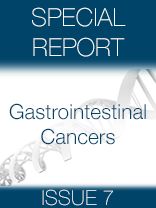FOLFOXIRI Bests FOLFOX as Bevacizumab Backbone in mCRC
Marginal improvements were seen in clinical outcomes for patients with metastatic colorectal cancer (CRC) treated with FOLFOXIRI plus bevacizumab compared with FOLFOX plus bevacizumab; however, these findings were inconsistent, according to results from the phase II STEAM trial.
FOLFOXIRI Bests FOLFOX as Bevacizumab Backbone in mCRC

Johanna Bendell, MD
Marginal improvements were seen in clinical outcomes for patients with metastatic colorectal cancer (CRC) treated with FOLFOXIRI plus bevacizumab compared with FOLFOX plus bevacizumab; however, these findings were inconsistent, according to results from the phase II STEAM trial presented at the 2016 Gastrointestinal Cancer Symposium.
In the study, nearly 60% of patients treated with FOLFOXIRI plus bevacizumab experienced an objective response versus 47% with FOLFOX plus bevacizumab. Median PFS with FOLFOXIRI was 11.4 months compared with 9.3 months with FOLFOX (HR, 0.704; 95% CI, 0.537-0.923).
The statistical significance of the efficacy findings varied, depending on whether bevacizumab was given sequentially or concurrently with chemotherapy. Adverse event rates were similar across the 3 treatment groups, including all treatment-emergent events, grade ≥3 adverse events, and withdrawals due to adverse events.
“Compared with FOLFOX and bevacizumab, the triplet regimen of concurrent FOLFOXIRI and bevacizumab demonstrated trends for improved objective response rate, progression-free survival, and metastatic resection rates,” said Johanna Bendell, MD, director of gastrointestinal cancer research at the Sarah Cannon Research Institute. “The present analysis of progression-free survival is preliminary, and updated results will be presented in the future. This still is not powered to compare overall survival results between treatment arms.”
In the STEAM study, investigators randomized patients with previously untreated mCRC to one of 3 treatment groups: concurrent bevacizumab plus FOLFOXIRI (cFOLFOXIRI), sequential bevacizumab plus FOLFOXIRI (sFOLFOXIRI), or FOLFOX-bevacizumab. Patients in all 3 groups received maintenance therapy with 5-FU, leucovorin, and bevacizumab or capecitabine plus bevacizumab.
At first progression, all patients received second-line treatment with an investigator’s choice fluoropyrimidine-based regimen plus bevacizumab. Follow-up continued until second progression. The primary endpoint was investigator-assessed objective response during first-line therapy for the cFOLFOXIRI-bevacizumab regimen versus FOLFOX-bevacizumab.
Data analysis comprised 280 randomized patients, who had a median follow-up of about 13 months. The patients had a median age of about 57, and 55% to 60% were men. Two-thirds of the patients had ECOG performance status 0, and 75% to 80% of the study population had colon cancer at diagnosis (as opposed to rectal). From 52% to 64% of patients across the 3 treatment groups had prior surgery.
About 30% of patients had liver-limited metastasis, left-sided tumor location was reported in 55% to 60% of cases, andKRASwild-type in about 25%, KRASmutant in about 25%, and KRASunknown in the rest.
The odds ratio for response was 1.7 in favor of cFOLFOXIRI versus FOLFOX-bevacizumab, but this did not achieve statistical significance. The odds ratio was 1.8 for sFOLFOXIRI versus FOLFOX-bevacizumab, which did achieve significance, as did pooled data for the 2 other treatment groups versus FOLFOX-bevacizumab.
The overall response rates were 60.2% with cFOLFOXIRI, 62.0% with sFOLFOXIRI, and 61.1% for the two groups combined. The hazard ratio versus the FOLFOX arm achieved statistical significance for the sFOLFOXIRI (HR, 1.8;P= .040) and combined analysis (HR, 1.8;P= .025).
For the second primary endpoint of progression-free survival (PFS), the cFOLFOXIRI regimen resulted in a statistically significant 2.4-month improvement in PFS versus FOLFOX. There was a 1.4-month improvement in PFS seen with sFOLFOXIRI versus FOLFOX but this improvement was not statistically significant.
The median PFS in first line was 11.7 months with cFOLFOXIRI, 10.7 months with sFOLFOXIRI, and 9.3 months with FOLFOX. The cFOLFOXIRI regimen achieved statistical significance versus FOLFOX, represented by a hazard ratio of 0.672 and confidence intervals that did not cross 1.0. The sFOLFOXIRI regimen resulted in a PFS hazard ratio of 0.738 versus FOLFOX, associated with confidence intervals that overlapped, making the difference nonsignificant.
More patients in the FOLFOXIRI groups had successful resection of liver metastases (15.1% for cFOLFOXIRI, 9.8% for sFOLFOXIRI, and 12.4% combined) compared with the FOLFOX group (7.4%). However, none of the differences achieved statistical significance (P= .555 to P= .094).
The cFOLFOXIRI group was associated with a higher rate of study discontinuation secondary to treatment-emergent adverse events (15% vs 3% for sFOLFOXIRI and 6% for FOLFOX). The cFOLFOXIRI arm also had a higher incidence of grade 3/4 hypertension.
In conclusion, Bendel said, “The interim results of STEAM align with findings from TRIBE, supporting the use of a FOLFOXIRI-bevacizumab regimen in a select group of first-line mCRC patients.”
The TRIBE trial demonstrated significant improvement in objective response and PFS, and a trend toward improved overall survival with FOLFOXIRI-bevacizumab as compared with FOLFIRI (5FU-leucovorin-irinotecan) plus bevacizumab (N Engl J Med. 2014;371:1609-1618). However, TRIBE left unanswered the question of whether FOLFOXIRI-bevacizumab is superior to FOLFOX plus bevacizumab.
References
- Bendell JC, Tan BR, Reeves JA, et al. Overall response rate (ORR) in STEAM, a randomized, open-label, phase 2 trial of sequential and concurrent FOLFOXIRI-bevacizumab (BEV) vs FOLFOX-BEV for the first-line (1L) treatment (tx) of patients (pts) with metastatic colorectal cancer (mCRC). J Clin Oncol 34, 2016 (suppl 4S; abstr 492).
